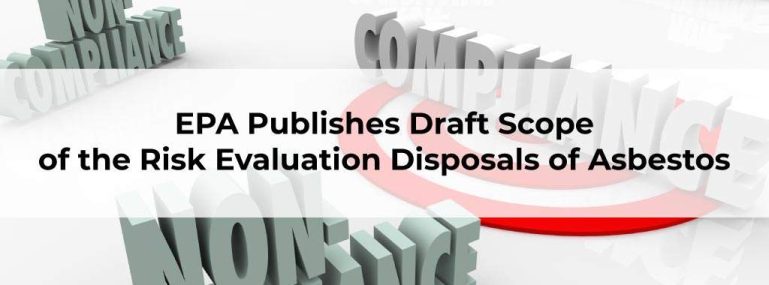Asbestos Risk Evaluation Part 2: Supplemental Evaluation for Legacy Uses and Associated Disposals of Asbestos Published by EPA.
On December 29, 2022, the U.S. Environmental Protection Agency (EPA) announced publication of the Draft Scope of the Risk Evaluation for Asbestos Part 2 (Draft Scope) for public comment). The EPA is currently evaluating the conditions of use of asbestos in Part 2 of the risk assessment, which will include evaluating other types of asbestos fiber, in addition to chrysotile, that were excluded from part 1 of the risk assessment due to their legacy uses and associated disposals, as well as any conditions of use of asbestos in talc and talc-containing products as discussed in this report. As part of the draft scope of their risk evaluation process, EPA plans to consider the conditions of use, hazards, exposures, as well as the Potentially Exposed or Susceptible Subpopulations (PESS) affected by this asbestos. EPA has started a 45-day public comment period on the Draft Scope so that the public can provide additional information, such as additional data, that may be helpful to EPA as it prepares the final scope of this risk assessment. The deadline for submitting comments to this draft scope is February 14, 2022.
In 2019, EPA continued developing the risk assessment focused on chrysotile asbestos. EPA has decided to release the full asbestos risk assessment in two parts. As reported in our January 4, 2021 issue, EPA is expected to release its final risk assessment for Asbestos, Part 1: Chrysotile Asbestos in December of 2020. Therefore, this allows EPA to move expeditiously into risk management in order to address the unreasonable risks identified in Part 1. According to the EPA, the final Part 2 Risk Evaluation for Asbestos must be published by December 1, 2024, at the latest.
In Part 2, the EPA plans to evaluate legacy uses of asbestos in the industrial, commercial, and residential sectors, as well as disposal practices associated with them. As part of the life cycle assessment, EPA will evaluate the conditions of use for the use and disposal phases. In addition to manufacture, processing, and distribution, where information implicates asbestos in talc, the conditions of use may also include the manufacture, processing, and distribution of talc.
As stated in the Draft Scope of Work, EPA intends to evaluate human and environmental exposures to asbestos and to evaluate releases to the environment resulting from the conditions of use of asbestos.
Additionally, more information will be gathered through systematic review, which will also supply additional context for expected exposures.
As part of the Part 2 risk assessment, the EPA will first evaluate the following pathways, routes, receptors, and PESS:
- Occupational exposure: The EPA would like to evaluate worker and occupational non-user (ONU) exposure to asbestos via inhalation, dermal, and oral route as they relate to the use and disposal of asbestos, including any implicated conditions of use for talc that contains asbestos.
- Consumer and bystander exposure: Asbestos exposure will be evaluated from inhalation, dermal, and oral exposure for consumers and bystanders through the use of asbestos in construction, paint, electrical, metal products, furnishing, cleaning, and treatment care products; packaging, paper, plastic, toys, and hobby products, automotive, fuel, agriculture, and outdoor use products. In addition, the direct contact and/or oral contact of products or articles containing asbestos for consumers is not described by any other codes. We will also assess whether any conditions of use for talc containing asbestos have been implicated.
- General population exposures: It is planned that the EPA will evaluate asbestos exposure via oral routes from drinking water, surface water, groundwater, and soil; through inhalation routes from particulates found in ambient air, and through skin exposure; and via the dermal route from contact with drinking water, surface water, groundwater, and soil within part 2 of the risk evaluation.
- PESS: As part of the risk assessment, EPA plans to include children, workers, ONUs, consumers, people who smoke, and bystanders as potential receptors and PESS, as well as any other PESS identified in the screening and evaluation of reasonably available information; and
- Environmental exposure: Within the scope of Part 2, the EPA plans to evaluate exposure to asbestos both for aquatic and terrestrial receptors within the scope of the conditions of use.
ComplianceXL offers strategic, business-oriented advice to the global chemical industry. It is our goal to assist large and small chemical companies whose activities and products may be subject to EPA’s broad chemical regulatory authority under the TSCA and state legislation on chemicals. Our global compliance experts are here to help you with any questions you may have.





